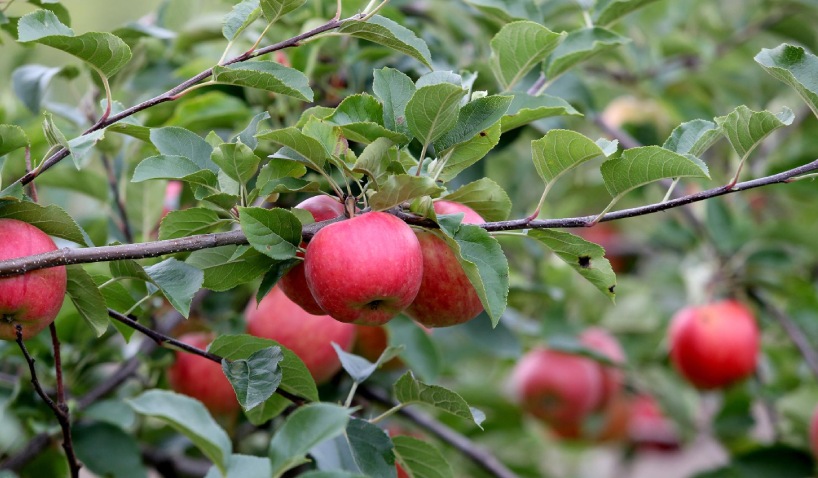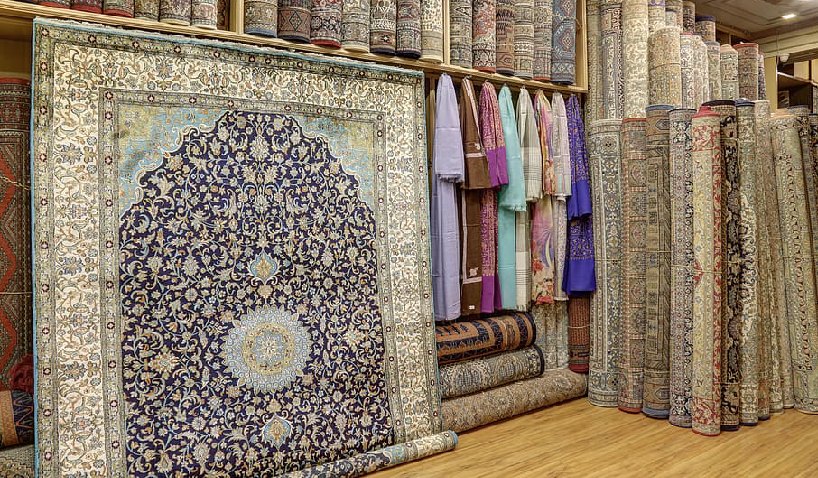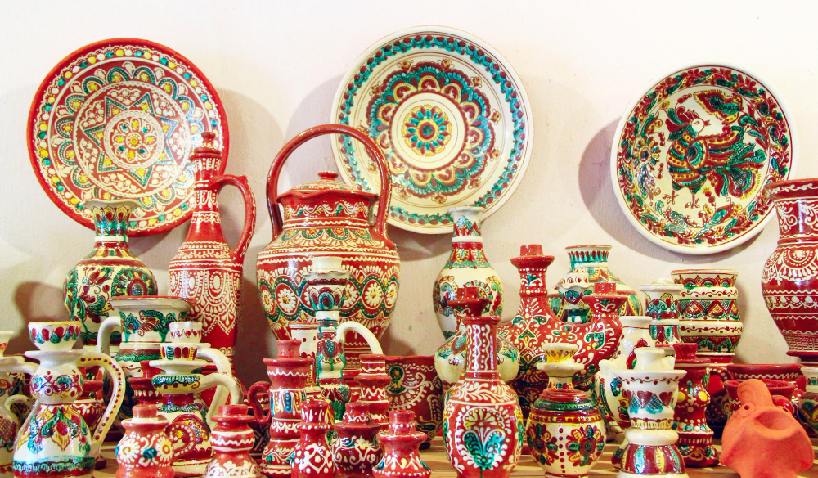The Ultimate Guide to Kashmiri Saffron: From Fields to Your Kitchen
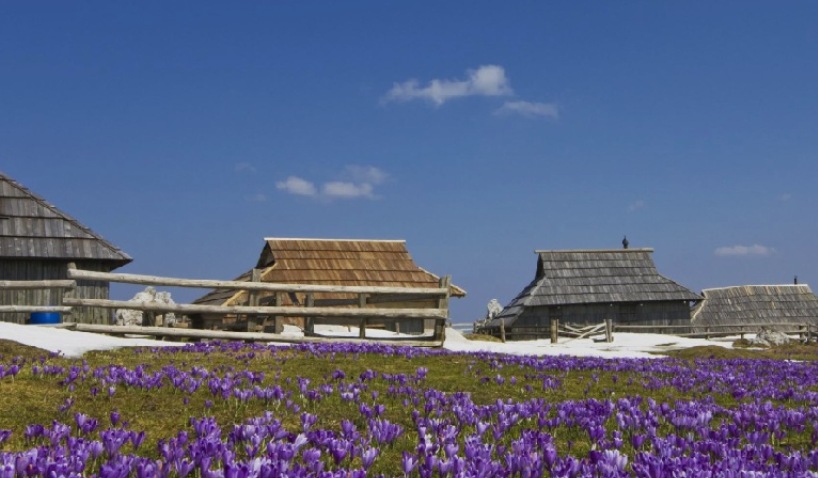
Kashmiri Saffron
Known as the “Golden Spice,” Kashmiri saffron is a symbol of India’s culinary prowess and rich history. This wonderful spice, which is grown in the pure valleys of Kashmir, has long been valued in Indian kitchens. The distinctive flavor, strong aroma, and deep red stigmas of Kashmiri saffron set it apart from other varieties.
In addition to being delicious, it has many health advantages, which is why traditional and Ayurvedic medicine use it extensively. Kashmiri saffron symbolizes purity, tradition, and well-being, whether it is used to enhance festive dishes or for its medicinal purposes. This spice, which is prized in Indian kitchens and customs, is a tribute to the eternal beauty and cultural diversity of Kashmir.
In addition to being delicious, it has many health advantages, which is why traditional and Ayurvedic medicine use it extensively. Kashmiri saffron symbolizes purity, tradition, and well-being, whether it is used to enhance festive dishes or for its medicinal purposes. This spice, which is prized in Indian kitchens and customs, is a tribute to the eternal beauty and cultural diversity of Kashmir.
The Rich Heritage of Kashmiri Saffron
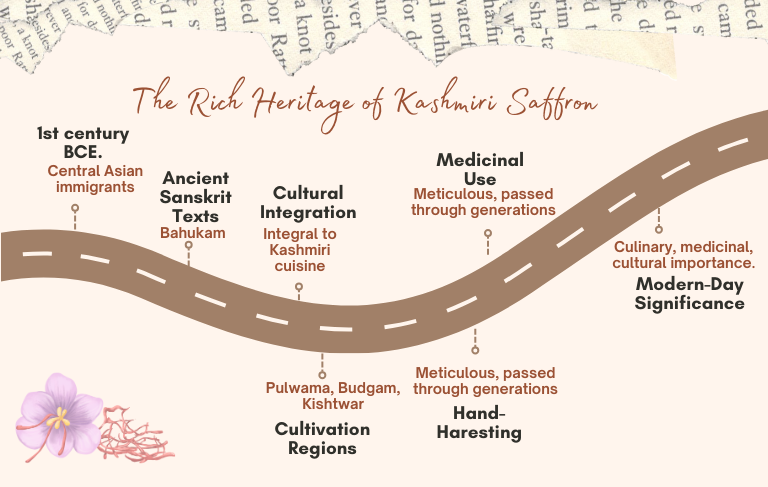
Kashmiri saffron, often referred to as “Kesar,” has a rich and illustrious history that dates back over two millennia. It is believed that saffron was introduced to the Kashmir Valley by Central Asian immigrants around the 1st century BCE. This golden spice, revered in ancient Sanskrit texts as ‘bahukam,’ quickly became an integral part of Kashmiri culture and cuisine.
The region’s unique climate and soil conditions, particularly in areas like Pampore, Pulwama, and Kishtwar, provide the perfect environment for saffron cultivation. The meticulous hand-harvesting process, passed down through generations, ensures that only the finest stigmas are selected, contributing to its unmatched quality and deep-red color.
Throughout history, Kashmiri saffron has been prized not only for its culinary uses but also for its medicinal properties, playing a significant role in traditional Ayurvedic practices. Its journey from ancient trade routes to modern kitchens underscores its enduring significance and value.
Exploring the history of Kashmiri saffron reveals a fascinating tale of cultural exchange, agricultural expertise, and the timeless allure of this exquisite spice, making it a cherished part of India’s heritage.
The region’s unique climate and soil conditions, particularly in areas like Pampore, Pulwama, and Kishtwar, provide the perfect environment for saffron cultivation. The meticulous hand-harvesting process, passed down through generations, ensures that only the finest stigmas are selected, contributing to its unmatched quality and deep-red color.
Throughout history, Kashmiri saffron has been prized not only for its culinary uses but also for its medicinal properties, playing a significant role in traditional Ayurvedic practices. Its journey from ancient trade routes to modern kitchens underscores its enduring significance and value.
Exploring the history of Kashmiri saffron reveals a fascinating tale of cultural exchange, agricultural expertise, and the timeless allure of this exquisite spice, making it a cherished part of India’s heritage.
Key Points
- Introduction to Kashmir: Central Asian immigrants, 1st century BCE.
- Ancient Sanskrit Texts: Mentioned as ‘bahukam’.
- Cultural Integration: Integral to Kashmiri cuisine.
- Ideal Cultivation Regions: Pulwama, Budgam, Kishtwar.
- Hand-Haresting Tradition: Meticulous, passed through generations.
- Medicinal Use: Ayurvedic applications.
- Trade Routes: Ancient trade significance.
- Modern-Day Significance: Culinary, medicinal, cultural importance.
Types of Kashmiri Saffron: A Guide to India’s Precious Spice
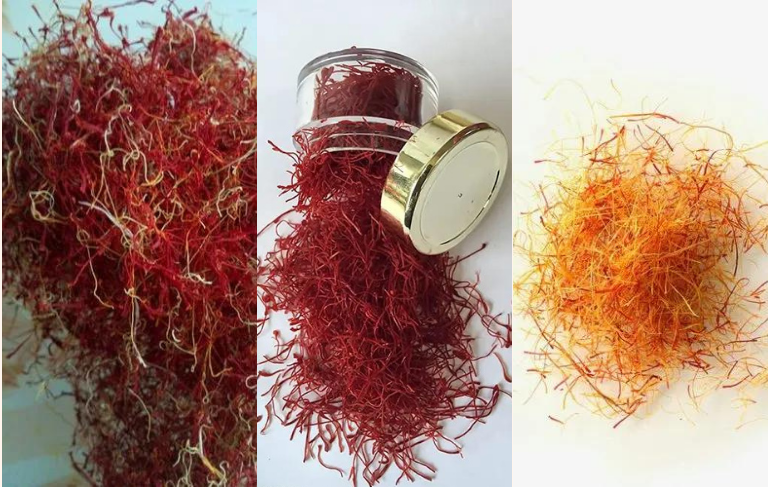
Saffron, known as the ‘red gold’ of Kashmir, is prized globally for its distinctive flavor, aroma, and vibrant color. The region of Kashmir produces some of the finest saffron in the world, celebrated for its quality and potency. Here are the main types of Kashmiri saffron:
- Lachha Saffron:The most expensive variety of saffron is Lachha, which is distinguished by its long, silky threads. It is perfect for both traditional medicinal uses and culinary masterpieces due to its potent flavor and strong aroma.
- Mongra Saffron: Compared to Lachha, this variety of saffron is made up of whole stigmas and is of a slightly lower grade. Saffron from Mongra is highly valued for its purity and is frequently used in cooking to give food a deep golden color and a delicate earthy flavor.
- Zarda Saffron: Zarda saffron is a lower grade variety that is commonly used for color and fragrance in dishes like biryanis and sweets. It is distinguished by its yellowish threads. It gives food preparations a subtle saffron flavor and makes them look better.
Characteristics of Kashmiri Saffron
Kashmiri saffron stands out globally due to its unique characteristics, making it one of the most sought-after varieties of this prized spice. Here’s why Kashmiri saffron is revered:
Rich Aroma and Flavor:
The exquisite hand-knotted structure of Kashmiri carpets is well known. To create the pile of the carpet, artisans painstakingly tie individual knots by hand onto the warp threads. Each knot adds to the carpet’s overall density, durability, and texture, so this process calls for accuracy and skill.Bright Color:
One of the best features of Kashmiri saffron is its deep crimson threads, which give food a deep golden tint. Home cooks and chefs appreciate this vivid hue for its aesthetic value as well as its ability to signal the strength and purity of the saffron.Long and Thick Stigmas:
During the harvest season, the long, thick stigmas (the threads) that make up Kashmiri saffron are hand-picked with great care. The substance that gives saffron its color and antioxidant qualities, crocin, is abundant in these strong threads.Labor-Intensive Harvesting:
Kashmiri saffron is mostly harvested by hand, in contrast to other saffron-producing regions that may use mechanized methods. The meticulous selection of the stigmas is ensured by this labor-intensive process, which adds to its superior quality.Medicinal Properties:
Beyond its culinary applications, Kashmiri saffron is prized for its therapeutic qualities. It is a mainstay in conventional medicine and wellness regimens because of its purported anti-inflammatory, mood-enhancing, and antioxidant properties.Geographical Indication (GI) Status:
The distinctive origin and age-old production techniques of Kashmiri saffron have been affirmed with the awarding of GI status. This accreditation protects its legitimacy and guarantees that customers will receive real Kashmiri saffron.Key Points
- Longer and Thicker Stigmas: Contributing to its superior quality.
- Deep-Red Color: Indicates purity and high crocin content, responsible for its coloring strength.
- High Aroma: Due to high safranal content, which gives saffron its distinctive fragrance.
- Bitter Flavor: Adds a unique taste to dishes.
- Chemical-Free Processing: Ensures natural and pure saffron.
Unveiling the Essence of Kashmiri Saffron Harvesting
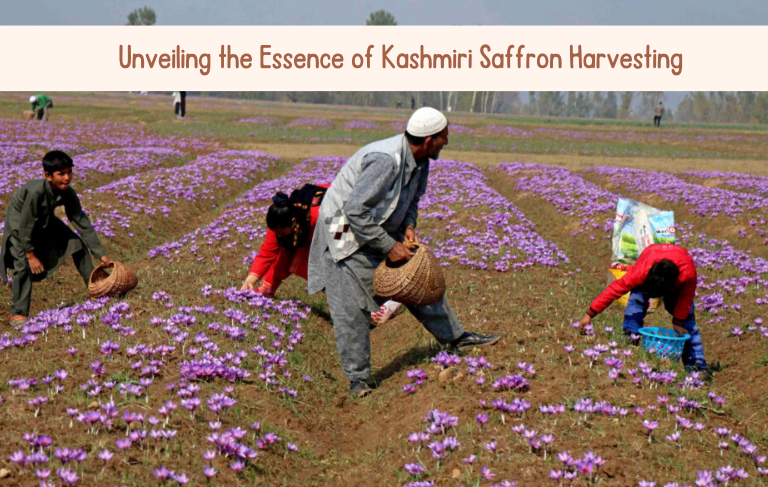
The meticulous care and tradition of harvesting saffron unfold in the beautiful valleys of Kashmir. To start, small Crocus sativus bulbs are sown in late summer, and people wait impatiently for their fall blooms. These purple flowers, which bear three priceless crimson stigmas, or saffron threads, appear in October and November.
Skilled farmers carefully handpick these delicate stigmas at the crack of dawn, making sure that only the best quality is selected. This manual method maintains generations-old methods that have been passed down through the centuries while also preserving the unique flavor and potent aroma of saffron.
After harvesting, the threads are carefully dried to preserve their strength and vivid color. Because of its commitment to quality and preservation of its legacy, Kashmiri saffron has been granted Geographical Indication (GI) status for its exceptional craftsmanship.
Kashmiri saffron is a symbol of the region’s unmatched culinary brilliance and rich agricultural heritage, found in kitchens all over India and in the fields of Pampore.
Skilled farmers carefully handpick these delicate stigmas at the crack of dawn, making sure that only the best quality is selected. This manual method maintains generations-old methods that have been passed down through the centuries while also preserving the unique flavor and potent aroma of saffron.
After harvesting, the threads are carefully dried to preserve their strength and vivid color. Because of its commitment to quality and preservation of its legacy, Kashmiri saffron has been granted Geographical Indication (GI) status for its exceptional craftsmanship.
Kashmiri saffron is a symbol of the region’s unmatched culinary brilliance and rich agricultural heritage, found in kitchens all over India and in the fields of Pampore.
Culinary and Medicinal Marvels of Kashmiri Saffron
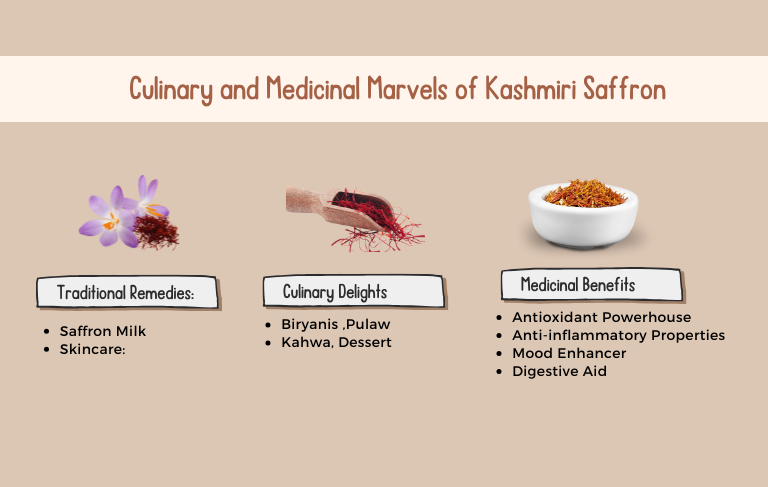
Culinary Delights:
Biryanis and Pulavs: Enhances aroma and imparts a rich golden hue.Mithais (Sweets): Elevates flavors of kheer, gulab jamun, and halwa.
Kashmiri Kahwa: Adds a delightful fragrance to this traditional tea.
Desserts: Used in ice creams, cakes, and ladoos for a luxurious touch.
Medicinal Benefits:
Antioxidant Powerhouse: Rich in crocin and safranal, it boosts immunity.Anti-inflammatory Properties: Soothes sore muscles and joints.
Mood Enhancer: Alleviates symptoms of anxiety and promotes relaxation.
Digestive Aid: Improves digestion and relieves bloating.
Traditional Remedies:
Saffron Milk (Kesar Doodh): Promotes better sleep and overall wellness.Skincare: Used in face masks for its anti-aging and skin-brightening effects.
Cultural Heritage:
Kashmiri saffron, with its Geographical Indication (GI) status, symbolizes the region’s rich culinary heritage and holistic healing traditions. From royal kitchens to everyday households, it continues to enchant with its unparalleled flavor, vibrant color, and myriad health benefits, making it an essential ingredient in Indian homes and kitchens.Tips for Buying and Using Saffron
Check Purity:
Look for saffron with deep-red stigmas and a slight orange-yellow hue at the tips.Avoid saffron that appears uniformly red or has white or yellow threads mixed in.
Smell Test:
Authentic saffron has a strong, sweet aroma.If the saffron lacks a distinct fragrance, it might be adulterated or old.
Avoid Powdered Saffron:
Powdered saffron is often adulterated with other substances.Whole threads ensure authenticity and purity.
Reputable Source:
Buy saffron from trusted suppliers or well-known brands.Check for certification labels like GI (Geographical Indication) to ensure quality.
Price Check:
Authentic saffron is expensive. Be wary of deals that seem too good to be true, as they might indicate adulteration.
To maintain your Kashmiri carpet’s beauty, longevity, and value, care is necessary. Here are some thorough instructions for taking good care of and maintaining your Kashmiri carpet:
Soak Before Use:
Soak saffron threads in warm water, milk, or broth for 15-20 minutes to release their flavor and color.Use the soaking liquid and threads in your recipes.
Proper Storage
Store saffron in an airtight container, away from light and moisture, to preserve its potency.A cool, dark place like a pantry is ideal.
Small Quantities:
Use saffron sparingly as a small amount goes a long way.Typically, a pinch is enough to flavor and color a dish.
Grind Threads:
For even distribution, grind saffron threads into a fine powder using a mortar and pestle before soaking.This method ensures maximum flavor extraction.
Add at the Right Time:
Add saffron towards the end of the cooking process to retain its delicate flavor and aroma.Avoid prolonged cooking to prevent loss of potency..
.
.
Saffron in Indian Festivals and Traditions
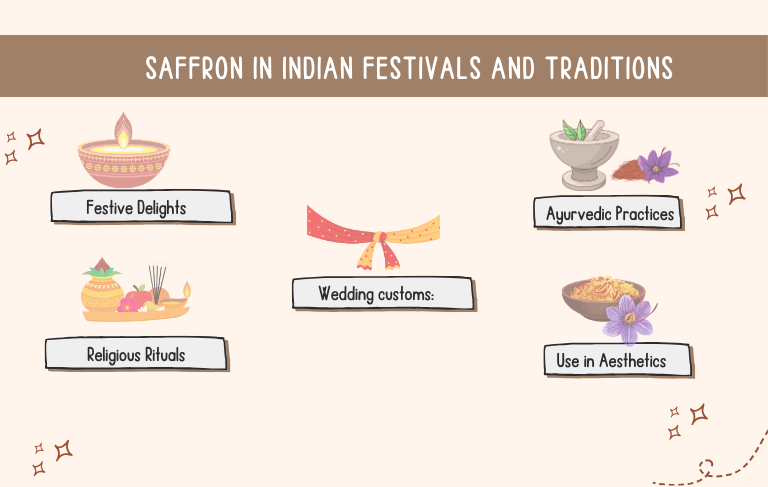
Did you know that saffron (kesar) is not just a spice, but a vital part of our festivals and traditions? Let’s explore the unique roles of saffron:
- Festive Delights: Saffron gives sweets like kheer, phirni, and gulab jamun a unique flavor and color during Diwali, Holi, and Eid.
- Religious Rituals:Saffron is a symbol of holiness and purity in poojas and havans. Donning a saffron tilak is regarded as fortunate.
- Wedding customs: Drinking saffron milk to ensure a happy and prosperous married life is one of the many wedding customs that use saffron.
- Ayurvedic Practices: Saffron is used in Ayurveda to reduce stress and promote mental clarity. During festive seasons, it is customary to sip saffron milk or water.
- Use in Aesthetics: The bride and groom’s faces are painted with a paste made of haldi and saffron to enhance their beauty and glow.
Why Saffron is the Most Expensive Spice of Kashmir
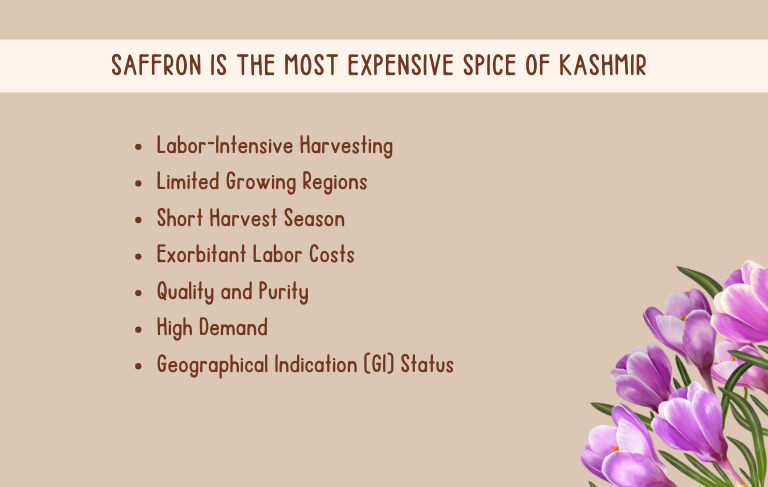
- Labor-Intensive Harvesting: Handpicking saffron threads from flowers is a meticulous and time-consuming process.
- Limited Growing Regions: Specific climatic and soil conditions in Kashmir limit large-scale production.
- Short Harvest Season: Saffron flowers bloom only once a year in autumn, requiring prompt and careful harvesting.
- Exorbitant Labor Costs: The physical labor required for planting, harvesting, and drying drives up expenses.
- Quality and Purity: Kashmiri saffron is prized for its potent fragrance, rich red threads, and high concentration of active ingredients.
- High Demand: In the culinary and medical fields, its distinct flavor, vivid color, and health benefits make it extremely desirable.
- Geographical Indication (GI) Status: This status ensures the authenticity and quality of Kashmiri saffron, adding to its exclusivity and price.
Benefits of Kashmiri Saffron
Centuries of history have seen the appreciation of Kashmiri saffron, a precious spice prized for its deep-red color, distinct aroma, and myriad health benefits. The following are some of the main advantages of Kashmiri saffron:- Rich in Antioxidants: Saffron contains potent antioxidants like crocin, safranal, and picrocrocin that help protect the body against oxidative stress and free radical damage.
- Natural Antidepressant: Studies have shown that saffron can help improve mood and alleviate symptoms of depression. It boosts levels of serotonin, the “happy hormone,” in the brain.
- Improves Circulation: Saffron can help reduce blood pressure and cholesterol levels, promoting better cardiovascular health. Its antioxidants help prevent heart disease by reducing arterial plaque buildup.
- Aids Digestion: Saffron is known to have anti-inflammatory qualities that can help with gastrointestinal problems. It can also increase appetite and digestion.
- Glowing Skin: Due to its capacity to lighten pigmentation, brighten skin, and enhance overall complexion, saffron is a common ingredient in skincare products. Its anti-oxidant qualities also aid in postponing the aging process.
- Enhances Immunity: Saffron’s high antioxidant content strengthens the immune system and aids in the body’s defense against diseases and infections.
- Treats Respiratory Conditions: By lowering inflammation in the lungs and airways, saffron can aid in the treatment of asthma and other respiratory disorders.
- Reduces Inflammation: People with arthritis and other inflammatory disorders may find relief from joint pain and inflammation thanks to saffron’s inherent anti-inflammatory qualities.
- Reduces PMS Symptoms: Saffron has been shown to reduce the intensity of headaches, cramps, and irritability that are associated with premenstrual syndrome (PMS).
- Helps with Weight Loss: Saffron can enhance satiety and decrease snacking, which can help with weight management and lower the risk of obesity.
Modern Applications of Saffron
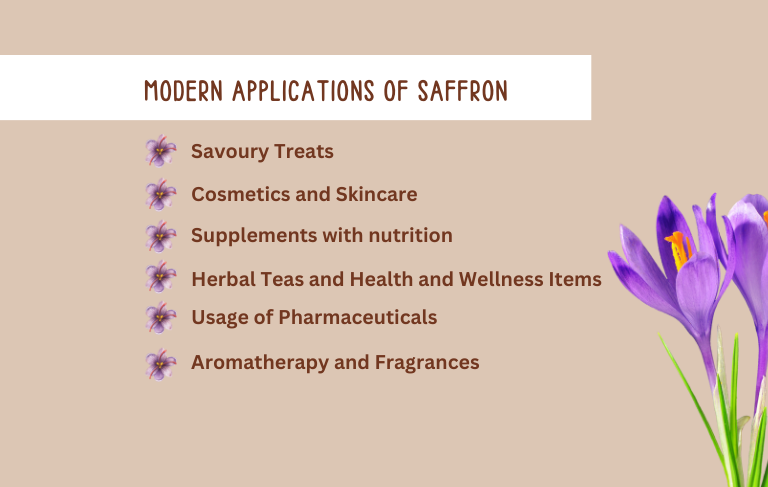
In contemporary times, saffron has transcended its traditional uses, finding applications in various modern industries due to its unique properties and benefits. Here are some of the key modern applications of saffron
